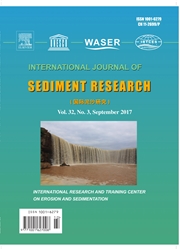

 中文摘要:
中文摘要:
Benthic 宏无脊椎动物是河生态系统的重要部件。宏无脊椎动物的分发上的河的过程和人的活动的效果通过领域调查和实验被学习。在中国的 31 条河里的 61 个采样地点被选择调查宏无脊椎动物集合的结构。根据他们的河的条件,当有一张稳定的隧道床,降级的隧道床, aggrading 隧道床,和集中的床的溪流装载运动,河被分类。为河的四种类型的宏无脊椎动物动物志的结构是很不同的。稳定的河有很多个人,丰富的动物志,和高生物多样性;当为降级的河的密度和 taxa 丰富是小的时,并且那些为 aggrading,河是少得多;而有集中的床负担运动的河的生态学是最糟。这份报纸建议那 streambed 稳定性是塑造 benthic 宏无脊椎动物社区的结构的主要有影响的因素。器官的污染能显然导致生物多样性的减少,在宏无脊椎动物结构的简化,并且在功能的喂的组作文的失真。在有高全部的氮内容的一条河里,相对许多 collector-gatherers 高,并且 collector-filterers, scrapers,切碎机,和食肉动物的是低的。Scrapers,切碎机,和食肉动物在严重地弄脏的河里消失。在单个数字和 taxa 丰富的不同减少的水的产地结果的隔离。这结果证明水的产地的连接显著地影响宏无脊椎动物集合。计算一个产地适用性索引(HSI ) 的一个实际方法被建议,集成效果主要物理(包括关於生命、不能生活) 并且化学因素。生物多样性和 taxa 丰富与 HSI 非线性地增加。
 英文摘要:
英文摘要:
Benthic macro-invertebrates are vital components of river ecosystems. The effects of fluvial processes and human activities on the distribution of macro-invertebrates were studied through field investigations and experiment. Sixty-one sampling sites on 31 rivers in China were selected to investigate the structures of macro-invertebrate assemblages. The rivers, according to their fluvial conditions, are classified as streams with a stable channel bed, degrading channel bed, aggrading channel bed, and intensive bed load motion. The structures of macro-invertebrate fauna for the four types of rivers are very different. Stable rivers have a large number of individuals, abundant fauna, and high biodiversity; while the density and taxa richness for degrading rivers are small, and those for aggrading rivers are much less; whereas the ecology of rivers with intensive bed load motion are the worst. This paper proposes that streambed stability is the primary influential factor shaping the structure of benthic macro-invertebrate communities. Organic pollution can obviously result in the decrease of biodiversity, in the simplification of macro-invertebrate structures, and in the distortion of functional feeding group composition. In a river with high total nitrogen content, the relative abundance of collector-gatherers is high, and that of collector-filterers, scrapers, shredders, and predators are low. Scrapers, shredders, and predators disappear in severely polluted rivers. The isolation of aquatic habitat results in a distinct decrease of individual numbers and taxa richness. This result demonstrates that the connectivity of aquatic habitat significantly affects macro-invertebrate assemblages. A practical method to calculate a Habitat Suitability Index (HSI) is proposed, integrating the effects of the primary physical (including biotic and abiotic) and chemical factors. The biodiversity and taxa richness increase non-linearly with HSI.
 同期刊论文项目
同期刊论文项目
 同项目期刊论文
同项目期刊论文
 期刊信息
期刊信息
